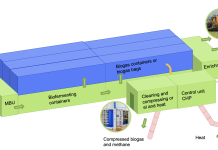Otto Terrell, Senior Sustainability Consultant, True, powered by Open Energy Market, navigates the challenges and opportunities in the UK Government’s push for solar on industrial rooftops
The recent move by the UK Government to promote solar power on industrial rooftops has been met with both optimism and scepticism. On the surface, the intention to cut red tape hindering businesses in their solar application processes is a positive step. However, the practical implementation of this strategy raises some concerns that firms should carefully consider.
Grid upgrades: financial implications & the guidance gap
Firstly, it is worth noting that while businesses increasing the size of their solar systems is often a logical step to maximise renewable energy generation, it comes with challenges. Significant upgrades to the existing grid infrastructure will be required to accommodate larger solar installations across the UK.
Plus, while recent laws prevent the entire cost of upgrades from burdening the applying business, many are still required to contribute to these costs. In some cases, the financial obligation for industrial-size business sites can amount to millions of pounds, impacting the viability of larger solar projects.
Moreover, the Government’s push may inadvertently lead to businesses making substantial investment decisions about their net zero strategies without sufficient guidance. For companies unfamiliar with solar technology, this poses a considerable challenge.
Without adequate consultancy on choosing the right solar providers or decarbonising technologies, renewable energy implementation is likely disconnected from sensible strategies and payment methods supported by data and expertise.
Understanding the nuanced details of solar panel placement further underscores the need for expert guidance. Even the direction in which solar panels are laid can significantly affect performance. In the UK, south-facing panels usually generate more electricity than other orientations because they perform best when the sun shines on them directly. Likewise, how an array of panels are grouped and connected can significantly impact their annual generation due to issues such as shading.
Beyond solar: a comprehensive energy strategy
Businesses must recognise that a comprehensive net zero strategy extends beyond solar alone. Solar is a powerful technology offering favourable cost versus payback, but it is not a one-size-fits-all solution. Although beneficial to many, roof-mounted solar arrays may only suit some businesses looking to decarbonise.
In light of these considerations, businesses should approach their net zero strategy with nuance and a well-thought-out policy approach. There may need to be more than just a focus on solar to achieve comprehensive decarbonisation. Instead, a diversified approach incorporating various renewable technologies should be considered. This involves integrating quantification, tracking, reporting, and implementation of both hardware and energy efficiency measures into an overarching strategy.
Striking the balance for sustainable decarbonisation
In conclusion, while the Government’s efforts to promote solar on industrial rooftops are a powerful step in the right direction, businesses must tread carefully. A well-rounded and effective net zero strategy involves considering a spectrum of renewable technologies, ensuring that the chosen solutions align with a company’s unique circumstances and goals. Businesses need expert guidance to make informed decisions and avoid potential pitfalls or holdups associated with hasty, uninformed investments.
One practical example of informed decision-making is leveraging platforms that use data modelling. These platforms can demonstrate how installing solar panels – comparing payment mechanisms such as Capital Expenditure (CapEx) and Leasing or Power Purchase Agreements (PPA) – can help critical decision-makers make choices that best suit their business and budget. This kind of hands-on approach provides the following:
- Tangible insights.
- Allowing businesses to remain in control of validating the efficacy of their prospective investments.
- Thus, making the transition to sustainable practices more concrete and tailored to the specific needs of each business.
As businesses embark on their renewable energy journey, they must balance the immediate and long-term benefits of their decarbonisation efforts. Through strategic planning, comprehensive analysis, and collaboration with trusted partners, businesses can position themselves to meet current legislative requirements and thrive in a future where sustainability is paramount.
For more information about energy procurement and renewable technologies, visit https://www.truezero.tech/














